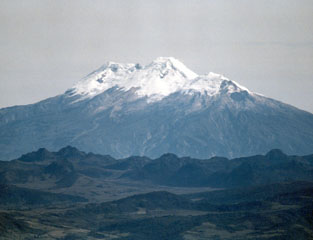Report on Nevado del Huila (Colombia) — 2 April-8 April 2008
Smithsonian Institution / US Geological Survey
Weekly Volcanic Activity Report, 2 April-8 April 2008
Managing Editor: Sally Sennert.
Please cite this report as:
Global Volcanism Program, 2008. Report on Nevado del Huila (Colombia) (Sennert, S, ed.). Weekly Volcanic Activity Report, 2 April-8 April 2008. Smithsonian Institution and US Geological Survey.
Nevado del Huila
Colombia
2.93°N, 76.03°W; summit elev. 5364 m
All times are local (unless otherwise noted)
According to news articles, communities surrounding Nevado del Huila responded to the raised Alert Level of Orange, established by INGEOMINAS on 29 March. The Local Committee of Disaster Prevention ordered the closing of a school with a student population of 1,100, declared the maximum alert for a local hospital, and facilitated meetings of multiple groups. Residents bought supplies and repaired roads that were key evacuation routes, and sirens were tested each day. Several populations in high-risk areas did not have systems of communication. On 7 April, residents in high-risk areas near the Páez river were evacuated to shelters as a precautionary measure.
On 8 April, INGEOMINAS lowered the Alert Level to Yellow due to decreased seismicity during 2-8 April. In addition, no superficial changes associated with the recent activity were observed during an overflight on 5 April.
Geological Summary. Nevado del Huila, the highest peak in the Colombian Andes, is an elongated N-S-trending volcanic chain mantled by a glacier icecap. The andesitic-dacitic volcano was constructed within a 10-km-wide caldera. Volcanism at Nevado del Huila has produced six volcanic cones whose ages in general migrated from south to north. The high point of the complex is Pico Central. Two glacier-free lava domes lie at the southern end of the volcanic complex. The first historical activity was an explosive eruption in the mid-16th century. Long-term, persistent steam columns had risen from Pico Central prior to the next eruption in 2007, when explosive activity was accompanied by damaging mudflows.
Sources: EL PAÍS, El Tiempo, Servicio Geológico Colombiano (SGC)

